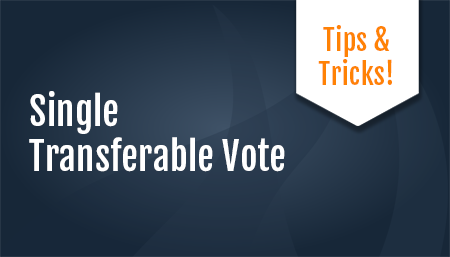Sep 6, 2011

STV is a voting system that’s based on voters using the Preferential Voting method to vote, with the results being tallied using proportional representation. And it seems to have gained a strong following because it ensures that every vote counts, to ensure a better level of democracy. It’s gained popularity in Europe, where countries have actually adopted STV for government elections. Ireland, Australia, and certain local government elections in the UK use STV. And the Academy of Motion Picture Arts & Sciences use it for their nomination process for the Academy Awards (Oscars). To learn more about STV, reference the Wikipedia article on STV, especially its External Links section.
Advantages and Disadvantages of STV
According to the ACE project, the advantages of STV are that it provides a better chance for the election of popular independent candidates than other tallying systems. It treats every vote and every voice with equal respect..
It is however is quite complex and demands a high degree of literacy and numeracy, which isn’t feasible for everyone. It can also produce pressure for political parties to fragment internally because members of the same party are competing against each other. Click here, to read the full article.
How it works
Winners are calculated according to these following steps:
- Any candidate who has reached or exceeded the number of votes needed to win is declared elected.
- If a candidate has more votes than the required amount of votes need to win, that candidate’s surplus votes are transferred to other candidates. Votes that would have gone to the winner instead go to the next preference listed on their ballot. These are generally called surplus votes.
- If no one new meets the number of votes needed, the candidate with the fewest votes is eliminated and that candidate’s votes are transferred.
- This process repeats until either a winner is found for every seat or there are as many seats as remaining candidate
To learn about how the process works, watch this video from Fairvote.org.
Surplus Votes
As previously stated, in STV when a candidate reaches the required number of votes, he/she won’t need the help of additional votes and those will get transferred to voter’s 2nd choice of a candidate. There is a wide variety methods for determining which votes get transferred. An example illustrates this: suppose candidate X, at a certain stage of the count, has 190 votes, and the quota is 200. Now X receives 30 votes transferred from candidate Y (after Y was either elected or eliminated). This gives X a total of 220 votes, i.e. a surplus of 20 to be transferred. But which 20 votes will be transferred? That’s what the different methods do:
- Cincinnati method – Under this method, votes are drawn at random from all votes – those received directly and transferred from other candidates. Using the above example, the random sample of 20 votes would be taken from all 220 votes. You can also use a random number generator to select ballots or in excel, the “=RAND()” function.
- Gregory method – All 220 votes are counted. They will be looked at for their second ballot, and then the totals will be scaled down to the 30 votes you went over. So of your 220 total votes and 30 surplus votes, if there were 40% for candidate X 30% for candidate Z, and 30% for candidate A, candidate X would receive 12 votes, and candidates Z and A would each receive 9 votes.
- Hare method – Votes are drawn at random only the transferred votes – the new votes that come in. It works on an order of when votes are received. Using the above example.20 votes are drawn from the 30 received from Y’s transfers in the order that the vote occurred. Any of the first 190 votes where candidate x was preferred will NOT be transferred.
For more information on how to count STV and surplus votes, click here.
How STV can be used in ElectionBuddy
- Within ElectionBuddy, you must choose preferential voting method. Ensure that election results are not published.
- Then run your election as you normally would until the close date.
- After the election is complete, you will manually tally your results.
- You can then use something like this STV Excel Template and implement that raw ballot data. Very simple to use! (Just make sure if you do use it, to omit the candidate’s name, when pasting in the results).
Feel free to let us know if you have tried STV tallying for an ElectionBuddy election before. Reach us at support@electionbuddy.com. We’d love to hear from you!